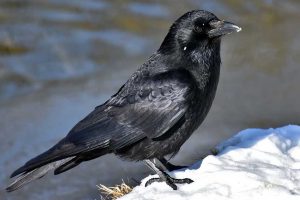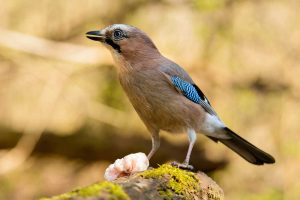Corvid is the collective term for the oscine passerines of the Corvidae genus – to you and me, members of the crow family. Oscine passerines are songbirds that perch to roost.
Globally there are over 120 species of corvid, eight of which live in the British Isles.
Table of Contents
How to recognise a corvid bird
Many of the birds share similar characteristics, although there are always exceptions to the rule.
- Their plumage is usually glossy and plain, featuring just one or two colours.
- It is difficult to differentiate between the sexes.
- Their voices are loud, often with harsh calls.
- Most corvids are gregarious at times; they don’t flee from close contact.
- Their social skills are highly involved, particularly when aiding a fellow bird.
- Some individual corvids have exceptional intelligence, recognising and remembering faces and their mirror image.

Members of the British Corvid Family
Carrion Crow – Corvus Corone
So-called for their propensity to devour roadkill and carcasses, the carrion crow is the most common corvid across Britain, the one we refer to as ‘crow’.
They inhabit most of the country, except for parts of Ireland.
Carrion crows are happy being alone or as part of a pair. They occasionally tag onto a flock of their species and other corvids, usually rooks and ravens.
Hooded Crow – Corvus Cornix
Although the same size as the carrion, the hooded crow is easily distinguishable by its grey body parts. It is rare to see both species in the same place, as hooded crows inhabit Ireland, north and west Scotland, and the Isle of Man. Occasional regions where the species overlap is infrequent and a fantastic photo opportunity.
Raven – Corvus Corax
Synonymous with guarding the Queen’s jewels in The Tower of London, ravens are the largest of the native corvids with a wingspan of 125cm. Strangely, they don’t inhabit other urban areas, preferring rural and upland areas with an abundance of food options.
They fly alone or in pairs and are recognisable in flight by the unusual diamond shape their tail feathers create.
Rook – Corvus Frugilegus
Rooks are large black corvids the same size as a hooded crow. They are common across much of Britain and flock with other corvids such as jackdaws and carrion crows. Common to large open spaces, rooks are also easy to spot feeding at the roadside. They prefer rural sites and rarely venture into towns and cities.
Unlike similar birds, the rook has a grey face and beak; identification is a little easier.
Jackdaw – Corvus Monedula
Jackdaws and rooks are often found together, comfortable in each other’s company. The jackdaw is a slightly smaller yet chunky bird and has some grey plumage amongst the black. Its beady white eye is a dead giveaway when attempting identification, as is the distinctive sheen at the back of its head.
They live in various habitats across much of Britain and make their nests in buildings, chimney stacks, and tree crevices.
Eurasian Magpie – Pica Pica
The most distinctive bird in the corvid family, easily identified by the flash of brilliant blue among the black and white plumage.
The magpie is surrounded by superstition and folklore however, they are highl- intelligent birds with somewhat of an unfairly bad reputation. That said, they happily feast on the eggs and nestlings of other bird species, but your family silver is safe.
They are intelligent birds and have a highly developed chack-chack call to warn off predators.
Chough – Pyrrhocorax Pyrrhocorax
Pronounced chuff, it is the smallest and has the smallest population of all British corvids. It resides only on the west coast where there are 250-350 breeding pairs; a further 120-150 pairs inhabit the Isle of Man. They prefer short grassland or rocky coasts and never venture inland.
Choughs put on dynamic aerial displays filled with swooping and diving acrobatics.
The chough is black like most other crows, but it’s red legs and bill it apart.

Jay – Garrulus Glandarius
Finally; the exception to the rule. The jay has very little black plumage instead it has a blush pink body with white and blue highlights and a black moustache.
Jays are tough to spot, they’re not outgoing like other members of the crow family; they are shy and introverted.
They are clever birds that cache acorns in autumn to feast on in winter when food is scarce. They mark their storage space with leaves or stones and take note of landmarks to remember exactly where their food is buried.
Final thoughts
It feels strange that all birds that are corvids are members of the crow family, yet only some of them look like the crows we recognise!
One last interesting fact;
A group of crows is called a murder; a name gleaned from their willingness to hover over battlefields and gallows in the hope of scavenging a juicy meal!
